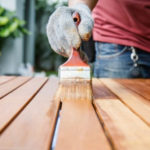Wood is one of the most important and common elements in construction projects. It’s so popular that a whole host of different types of wood are used for different purposes.
Plywood is a type of wood that is extremely versatile because it can be used both indoors and outdoors. It’s also one of the cheapest. In fact, plywood was one of the first building products to be made affordable to the general public.
It can be used both for siding or as a roofing material. You can usually find it at any home improvement or lumber store.
That means you’ve got lots of options when it comes to using plywood in your projects, but you also need to know that you’re going to need to waterproof the material.
Plywood can warp, crack and split if it fails to be protected against moisture, causing a headache for your contractor or a potential fire hazard for you, the homeowner.
When you use plywood for an outdoor project, you want to make sure that it stays protected from the elements. By waterproofing your plywood, you will protect it and ensure that it lasts for years to come.
Various Ways to Waterproof Plywood
Some types of plywood are naturally resistant to water and even moisture. For example, baltic birch veneer plywood is typically bonded with birch underlayment.
It contains a waterproof glue substance called phenolic resin that resists damage from water and stains for the life of the wood.
That said, there are still times when you should still consider some form of treatment for your plywood even if it was treated in its original manufacturing as some factors like construction and time can affect what type of protection may be needed.
If you’re looking for waterproof wood, you have two main choices: latex and polyurethane. Using latex or a polyurethane sealer will help protect the wood from the elements, so you can build outside structures that withstand rain, wind, and more.
Application
If you are using plywood for building purposes, make sure that you clean the wood surface before you put on the protective substance. You do not want to get any dirt and debris into the final project.
If you do not know how to effectively clean a specific wood type, we strongly suggest approaching a professional for assistance.
Make sure that when you are cleaning the wood you use a recommended solvent as these tend to be more effective than plain water or soap.
You may also need to sand down the surface of wood pieces with rough patches in order to get as smooth and clean of an application as possible. This is important because otherwise, the waterproofing may not take properly and will result in an uneven finish.
The first thing to do is determine what you want to use the plywood for. If it is going to be used as a building material, the wood must be treated thoroughly, with additional measures added depending on how it will be seen.
If it is just for decoration, you can use a very simple paint, varnish, or wax finish.
Is Pressure Treated Plywood Waterproof?
Most pressure-treated plywood will resist damage from water exposure. However, this is not the same thing as the plywood being waterproof.
Resistance to water exposure means the wood is less likely to absorb water and swell — which can still lead to water damage.
Pressure treated plywood is not waterproof or resistant to moisture. This is from exposure to rain, dew, standing water or condensation. Any amount of water that comes in contact with the wood will weaken the surface and cause it to decay.
How Long Will Untreated Plywood Last Outside?
If you had a piece of untreated and unsealed plywood, and you used it on an outdoor structure, it would last about 2 years.
It is best to treat plywood prior to use outdoors. If not properly treated, the moisture in the air will irritate the wood and it will swell. This swelling will cause the plywood to warp, bend and bow.
This results in a very unstable and unsafe structure to be standing on. The most important factor when deciding whether or not to use untreated wood for an outdoor project is the amount of time you plan on leaving it outside.
Should You Always Seal Plywood Before Painting?
It’s best to seal the plywood and then add the top coat of paint. Just a small time investment now can help you avoid having to replace moldy, rotted plywood later.
Sealing plywood creates a barrier between the sheet’s surface and its paint covering. The goal is to seal any visible joints or cracks that water can seep through.
Sealing plywood allows water to sit on the surface without affecting the paint. While dried paint may appear to be seeping into the wood, it’s actually sitting on top of the layer of clear coat created above it.
Will Polyurethane Waterproof Plywood?
Polyurethane is one of the most popular protective finishes on hardwoods and on wood furniture. It provides a protective layer making it harder for water to penetrate into the wood.
But, it is not waterproof; rather, it’s water-resistant. Normally, polyurethane finish protects wooden surfaces for up to two years after application.
What Should I Use to Seal Plywood?
Sealing plywood is an important step in the construction process of many projects. Plywood sheets are used for walls, floors, roofs, and a variety of other construction projects.
When constructing with plywood it is best to seal the plywood edges. This prevents moisture from entering the wood. This can prevent expansion and can cause the sheets to separate or warp which causes the edges to split from the plywood panel.
The reason for this is that the joints are often exposed to moisture, sunlight, or insects.
Does Epoxy Waterproof Plywood?
Epoxy is the most widely used marine sealant and also used in the production of boats, yachts, or vessels. It is often mixed with fiberglass cloth to strengthen and add water resistance.
You need fiberglass or carbon fabric and liquid epoxy resin, with this mixture you will get long-lasting water resistance.
Make sure you have a smooth and clean surface first, then apply a first coat of diluted epoxy resin. The second application shouldn’t be more than 4-8%, while the third and the fourth should not exceed 2%




